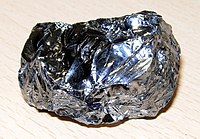
Photo from wikipedia
The selective fluorescence sensing of hypochlorite (ClO-) was achieved at pH 7.4 by a simple analytical procedure through the fluorescence quenching of autoclave synthesized carbon dots (CDs), which used as… Click to show full abstract
The selective fluorescence sensing of hypochlorite (ClO-) was achieved at pH 7.4 by a simple analytical procedure through the fluorescence quenching of autoclave synthesized carbon dots (CDs), which used as precursor an adduct formed between 3-aminophenylboronic acid (APBA) and alizarin red S (ARS). The use of this adduct allowed the preparation of CDs with a red shifted emission (560 nm) and excitation in the visible range (490 nm). Quantification of hypochlorite was achieved at physiological pH (pH 7.4) in aqueous solutions by fluorescence quenching with a linearity range of 0-200 μM (limit of detection of 4.47 μM, and limit of quantification of 13.41 μM). The selectivity of hypochlorite sensing was confirmed by comparison with other potential analytes, such as glucose, fructose and hydrogen peroxide. Finally, the validity of the proposed assay was further demonstrated by performing recovery assays in different matrices. Thus, this CDs allows the fluorescent sensing of ClO- with spectral properties more suitable for in vitro/in vivo applications.
Journal Title: Talanta
Year Published: 2020
Link to full text (if available)
Share on Social Media: Sign Up to like & get
recommendations!